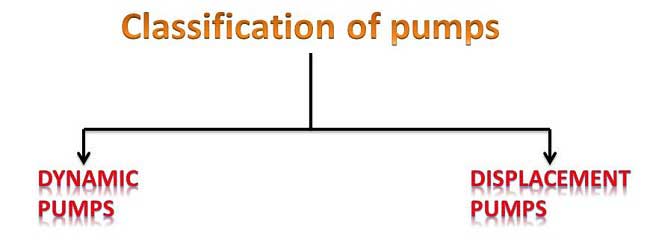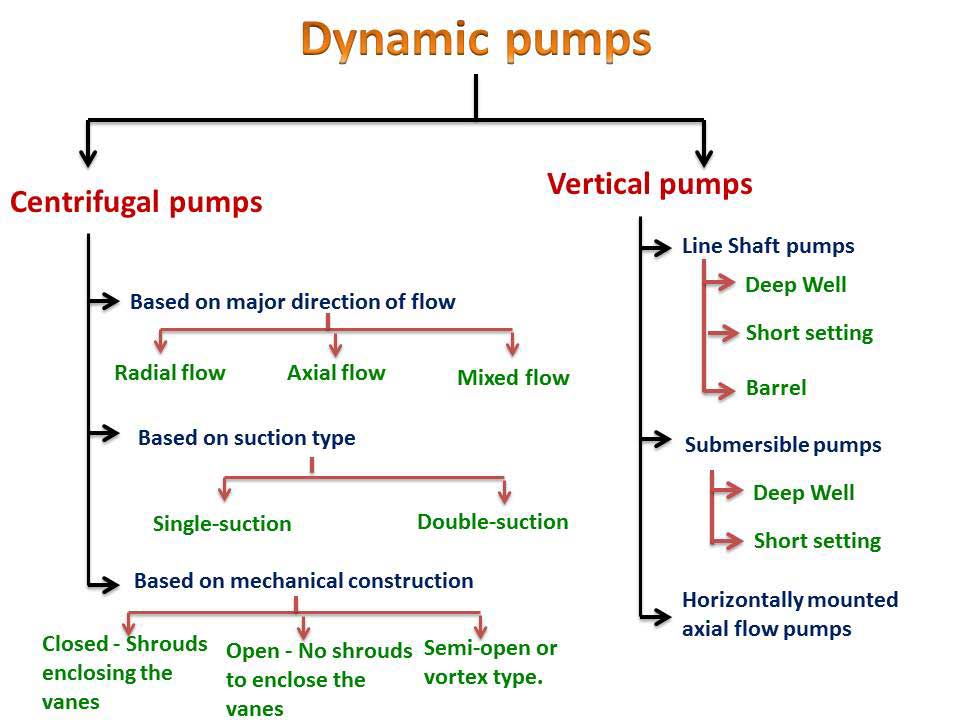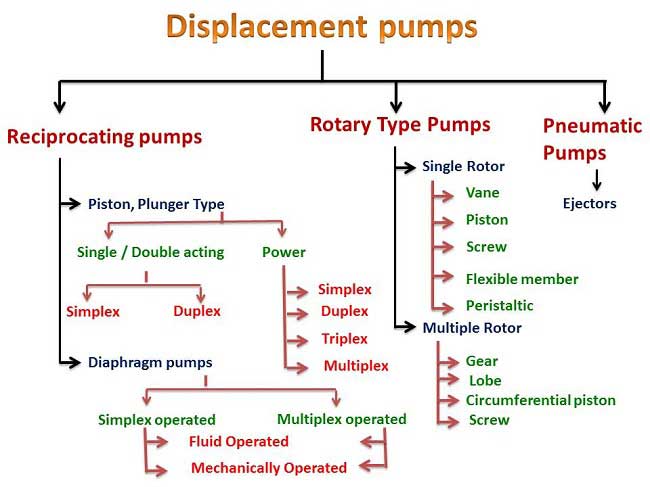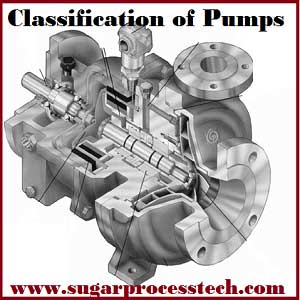Types of Pumps and their working principles with applications
Generally Pumps classification done on the basis of its mechanical configuration and their working principle.
Classification of pumps mainly divided into two major categories:
1.. Dynamic pumps / Kinetic pumps
2. Displacement Pumps / Positive displacement pumps
 Dynamic Pumps
Dynamic Pumps
Dynamic pumps impart velocity and pressure to the fluid as it moves past or through the pump impeller and, subsequently, convert some of that velocity into additional pressure. It is also called Kinetic pumps
Kinetic pumps are subdivided into two major groups and they are centrifugal pumps and positive displacement pumps.
Classification of Dynamic Pumps
Centrifugal Pumps
A centrifugal pump is a rotating machine in which flow and pressure are generated dynamically. The energy changes occur by virtue of two main parts of the pump, the impeller and the volute or casing. The function of the casing is to collect the liquid discharged by the impeller and to convert some of the kinetic (velocity) energy into pressure energy.
Centrifugal pumps are subdivided into several categories, as shown in above Figure
Radial Flow:
The impeller discharges fluid at right angles to the shaft axis. In this centrifugal pump in which the pressure is developed wholly by centrifugal force. The radial type pumps are used for the application of high head and low discharge.
In radial flow pumps ratio of impeller outside Dia ( D2) to eye Dia ( D1) is 2 or more and impeller having narrow width.
Mixed Flow :
The flow direction is partly axial and partly radial. Hence has a result the flow is diagonal. The mixed flow type pumps are used for the application of medium head and high discharge.
In this centrifugal pump in which the pressure is developed partly by centrifugal force and partly by the lift of the vanes of the impeller on the liquid.
In mixed flow pumps ratio of impeller outside Dia ( D2) to eye Dia ( D1) less than 1.5 and impeller having wider width.
Axial Flow:
The flow through impeller is parallel to shaft axis low head and very high discharge. The axial flow type pumps are used for the application of medium head and high discharge.
In this centrifugal pump in which the pressure is developed by the propelling or lifting action of the vanes of the impeller on the liquid.
In axial flow pumps ratio of impeller outside Dia ( D2) to eye Dia ( D1) is one and impeller having no width.
Axial, Radial and mixed flow pumps impeller dimensions
Specific speed ( Ns ) of the centrifugal pump identifies the approximate acceptable ratio of the impeller eye diameter (D1) to the impeller outside diameter (D2) in designing a good impeller.
Specific Speed (Ns): 500 to 5000; > 1.5 – radial flow pump
Ns: 5000 to 10000; < 1.5 – mixed flow pump
Ns: 10000 to 15000; = 1 – axial flow pump
Axial Split-Case Pumps
Axial split-case pumps have a casing that is split along the center line of the shaft. The impellers can be readily exposed for service and inspection by removing the upper half of the casing. It is also called horizontal split or horizontal split-case pump. Axial-split pumps may be single stage or multistage for higher pressures.
The pumps are usually mounted with shafts in the horizontal position, but vertically mounted pumps for reduced floor space are also available.
Vertical Pumps
Vertical pumps were originally developed for well pumping. The bore size of the well limits the outside diameter of the pump and so controls the overall pump design.
Vertical pumps can be subdivided into three major categories:
- Lines-shaft pumps
- Submersible pumps
- Horizontally mounted axial-flow
Line-shaft Pumps:
The driver is mounted on the discharge head for these type of motors. The line-shafting extend through the column to the bowl assembly and transmits torque to the pump rotor.
Submersible Pumps
Submersible pumps are close-coupled pumps driven by a submersible motor and designed for submerged installation in a wet well. The motor is mounted below the bowl assembly and is directly coupled to the pump rotor shaft.
Displacement Pumps
Positive displacement pumps, the moving element (piston, plunger, rotor, lobe, or gear) displaces the liquid from the pump casing (or cylinder) and, at the same time, raises the pressure of the liquid. So displacement pump does not develop pressure; it only produces a flow of fluid.
Classification of Displacement Pumps
The mainly Positive displacement pumps are subdivided into three categories as follow
- Reciprocating pumps
- Rotary pumps
- Pneumatic pumps.
Reciprocating pumps:
In a reciprocating pump, a piston or plunger moves up and down. During the suction stroke, the pump cylinder fills with fresh liquid, and the discharge stroke displaces it through a check valve into the discharge line.
Reciprocating pumps can develop very high pressures. Plunger, piston and diaphragm pumps are under these type of pumps.
Plunger / piston type pumps:
The plunger contains the cross head, driven by a cams haft arrangement. The capacity of the pump can be adjusted by changing the stroke, the rotating speed of the pump, or both. The stroke of the pump is changed by the eccentric pin setting.
These types pumps used for the application of sewage, sludge, scum, clarifier thickener underflow. It can be applied for transfer and for metering service. Such pumps are available in single- and multi cylinder models.
Diaphragm pumps :
These type of pumps are quite versatile, handling a wide variety of fluids like food additives, chemicals, dry powders, slurries, pharmaceutical products, and wastewater etc. The advantages in diaphragm pumps is the absence of seals or packing, meaning they can be used in applications requiring zero leakage.
Rotary Type Pumps
The pump rotor of rotary pumps displaces the liquid either by rotating or by a rotating and orbiting motion. The rotary pump mechanisms consisting of a casing with closely fitted cams, lobes, or vanes, that provide a means for conveying a fluid.
Vane, gear, and lobe pumps are positive displacement rotary pumps.
Rotary Lobe Pumps
Lobe pumps contains two elastomer-coated rotors that are driven by an integral gear box and synchronized by timing gears. The rotors run without touching each other or the casing. The liquid is drawn through the inlet port into the pockets between the lobes and chamber walls. Because liquid cannot escape between the two rotors, it discharges in the direction of rotation of the outer lobes through the discharge nozzle.
Screw Pumps
Screw pumps are a special type of rotary positive displacement pump in which the flow through the pumping elements is truly axial. Screw pumps are high-volume, non-clog, atmospheric -head devices that can pump a variety of solids and debris in raw waste water without screening. Screw pumps, however, have a practical limitation as to pumping head.
Progressive Cavity Pumps
A progressive cavity pump is designed specifically to transfer abrasive and viscous fluids with a high solid, fiber, and air content. A hard steel screw rotor rotates and orbits within an elastomer stator.
Pneumatic Pumps
Compressed air is used to move the liquid in pneumatic pumps. In pneumatic ejectors, compressed air displaces the liquid from a gravity-fed pressure vessel through a check valve into the discharge line in a series of surges spaced by the time required for the tank or receiver to fill again.
We hope this article “Classification of pumps | Types of pumps and their working principles” helpful to learn basic concepts regarding types of pumps . So we requested you please give feed back, comments to improve this and don’t forget to share it.
Related Articles :
Fundamental Concepts of Overall Heat Transfer Coefficient (OHTC)









14 thoughts on “Classification of pumps | Types of pumps and their working principles”
Bikram pal
(January 26, 2019 - 8:10 am)It was really helpful
vineeta gautam
(March 31, 2019 - 7:15 am)It is very helpful to gain yhe the knowledge of pumps
siva alluri
(April 1, 2019 - 3:45 pm)Thank you Vineeta gautam
Sudarshan
(April 1, 2019 - 10:49 am)Informative post on pumps…Thanks for sharing
siva alluri
(April 1, 2019 - 3:44 pm)Thank you Mr.Sudarshan
Vikash
(June 21, 2019 - 7:53 am)Good work
siva alluri
(June 21, 2019 - 4:21 pm)thank you
pawan kashyap
(September 4, 2020 - 3:57 am)This is very helpful information for plant engineers and others. Thanks for your knowledge. all the best
siva alluri
(September 7, 2020 - 4:45 am)Welcome
vitthal
(October 24, 2020 - 2:00 pm)Thank u for this very good information
siva alluri
(October 25, 2020 - 2:25 pm)Welcome
N D Chavan
(September 28, 2022 - 4:14 pm)R/Sir,
Please upload 2500 tcd devc+quad condensate generation calculation
siva alluri
(October 1, 2022 - 3:27 pm)Ok we will upload soon
The Classification of Pumps
(January 19, 2023 - 1:15 pm)[…] Source – Classification of pumps | Types of pumps and their working principles (sugarprocesstech.com) […]